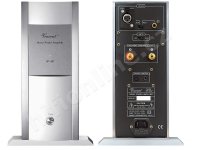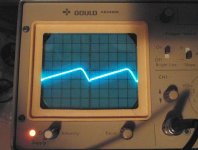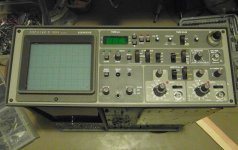Hi Everyone!
I am in desperate need of help concerning the disassembly of those monoblocks.
The main filter caps are dried out and swollen, so I want to replace them, but I am totally puzzled about how to take them apart.
I removed all possible screws holding the structure together, but the thing just don't want to come apart. It loks like I must remove the output transistors somehow in order to access the rest, but either way it is a major PITA.
Anyone ever worked on those, and if yes, any useful advice?
Thanks: Andrew
I am in desperate need of help concerning the disassembly of those monoblocks.
The main filter caps are dried out and swollen, so I want to replace them, but I am totally puzzled about how to take them apart.
I removed all possible screws holding the structure together, but the thing just don't want to come apart. It loks like I must remove the output transistors somehow in order to access the rest, but either way it is a major PITA.
Anyone ever worked on those, and if yes, any useful advice?
Thanks: Andrew
Bummer... Anyway, finally I managed to take it apart, not wishing to anyone to try it, real nightmare.... 🙁
Hi Andrew,
I"m glad you finally got into it.
Does it run especially hot inside the case? If it doesn't, then you may not need main filter capacitors. How old is it?
-Chris
I"m glad you finally got into it.
Does it run especially hot inside the case? If it doesn't, then you may not need main filter capacitors. How old is it?
-Chris
It is about 17-18 years old, runs quite warm, but not hot (50-55 celsius).
The problem was, that the top part of the filter caps bulged up, also I measured them, instead of 10000 uF I got 6500, and 7100 uF.s on them. The new ones I put in measured 10500 and 10800 uf. And yes, I replaced them with 105 degree versions....
The problem was, that the top part of the filter caps bulged up, also I measured them, instead of 10000 uF I got 6500, and 7100 uF.s on them. The new ones I put in measured 10500 and 10800 uf. And yes, I replaced them with 105 degree versions....
Hi Andrew,
That's pretty warm for a case temperature. Wise choice. The original ones were certainly toast!
Better check / replace the rest of the electrolytic capacitors. They don't like that environment very much. I'll bet the amplifiers will sound a lot better after this.
-Chris
That's pretty warm for a case temperature. Wise choice. The original ones were certainly toast!
Better check / replace the rest of the electrolytic capacitors. They don't like that environment very much. I'll bet the amplifiers will sound a lot better after this.
-Chris
Interesting, but the rest (few) electrolitycs are 105 C types, and they are OK.
While I was "inside" I also replaced those horrendous industrial cube rectifiers with ultrafast recovery diodes (BYW 29-200).
It is a surprisingly nicely built (except serviceability...) and good sounding amp, with plenty of power reserve, I like them very much
While I was "inside" I also replaced those horrendous industrial cube rectifiers with ultrafast recovery diodes (BYW 29-200).
It is a surprisingly nicely built (except serviceability...) and good sounding amp, with plenty of power reserve, I like them very much
Attachments
Last edited:
You might have just created a problem with those rectifiers. Your supply might ring now.
What most people do not understand is that "those horrendous industrial cube rectifiers" are highly engineered to do what they do. In fact, the only reason they are so inexpensive is not because they are "cheap" in any way. The economies of scale dictate the prices in the real (industrial) world. If the ultrafast recovery diodes were the best for the application, they would be in wide use industrially. Those were created for use in switching power supplies. Low volume = high price (and people deciding they are better in some way for normal rectification).
Anyway, you pulled a perfectly good and well engineered rectifier bridge from your amplifiers and installed something that will probably create ringing in your application.
I stock all kinds of rectifiers for service work. Guess what I use if I'm doing an "all out super job" on a piece of equipment for me? Normal rectifiers, and I sometimes reduce power supply capacitance, especially in tube products. If there was any advantage to be had in using fast recovery rectifiers, all my own equipment would have them installed.
-Chris
What most people do not understand is that "those horrendous industrial cube rectifiers" are highly engineered to do what they do. In fact, the only reason they are so inexpensive is not because they are "cheap" in any way. The economies of scale dictate the prices in the real (industrial) world. If the ultrafast recovery diodes were the best for the application, they would be in wide use industrially. Those were created for use in switching power supplies. Low volume = high price (and people deciding they are better in some way for normal rectification).
Anyway, you pulled a perfectly good and well engineered rectifier bridge from your amplifiers and installed something that will probably create ringing in your application.
I stock all kinds of rectifiers for service work. Guess what I use if I'm doing an "all out super job" on a piece of equipment for me? Normal rectifiers, and I sometimes reduce power supply capacitance, especially in tube products. If there was any advantage to be had in using fast recovery rectifiers, all my own equipment would have them installed.
-Chris
Dear Chris!
Thanks for your reply, amd "warning", but there are a few points worth to note about this subject.
I am an alectrical engineer, working in the audio field for some 30+ years, having quite some experience in the field of -mostly- loudspeaker , and amplifier design.
Instead of going into detailed discussion or debate about the use of ultrafast -or Schottky- rectifiers in audio applications, read the attached little article, that explains the reason, why they are better than tarditional "slow" rectifiers for this purpose.
And no, they don"t ring, you can see this yourself on a decent scope (of course attention should be paid in certain situations for "snubbing" the circuit)
And at last -but not the least- yes, the resulting sound is better when you use those fast types, the sound becomes smoother, cleaner, with less "grain", the noise floor lowers, improving the scale of perceived dynamics.
This is not theoretical mumbo-jumbo, but tried, tested, proven many times not only by me, but many of those manufacturesrs who use fast rectifiers in their designs by default.
Thanks for your reply, amd "warning", but there are a few points worth to note about this subject.
I am an alectrical engineer, working in the audio field for some 30+ years, having quite some experience in the field of -mostly- loudspeaker , and amplifier design.
Instead of going into detailed discussion or debate about the use of ultrafast -or Schottky- rectifiers in audio applications, read the attached little article, that explains the reason, why they are better than tarditional "slow" rectifiers for this purpose.
And no, they don"t ring, you can see this yourself on a decent scope (of course attention should be paid in certain situations for "snubbing" the circuit)
And at last -but not the least- yes, the resulting sound is better when you use those fast types, the sound becomes smoother, cleaner, with less "grain", the noise floor lowers, improving the scale of perceived dynamics.
This is not theoretical mumbo-jumbo, but tried, tested, proven many times not only by me, but many of those manufacturesrs who use fast rectifiers in their designs by default.
Attachments
Last edited:
Also, -without wanting to offend anyone- those "highly engineered" industrial rectifiers are nothing more, than four standard -garden variety- silicon diodes encapsulated in a plastic, or metal housing.....
Hi,
Yes, I know. It is those rectifiers that are chock full of engineering. I've found the best solution to hardness or "grain" is in the design and layout of the amplifier. I have yet to see a common rectifier as the cause for such an impression.
I see ringing with both my Tek 2465B and Agilent 54642D. Don't need convincing, but each situation is different I guess. I'm glad yours aren't causing any HF noise.
Always remember, "-garden variety- " doesn't mean not highly engineered. What you want to do is go with synchronous rectification. I don't think either of us would complain about that.
-Chris
Yes, I know. It is those rectifiers that are chock full of engineering. I've found the best solution to hardness or "grain" is in the design and layout of the amplifier. I have yet to see a common rectifier as the cause for such an impression.
I see ringing with both my Tek 2465B and Agilent 54642D. Don't need convincing, but each situation is different I guess. I'm glad yours aren't causing any HF noise.
Always remember, "-garden variety- " doesn't mean not highly engineered. What you want to do is go with synchronous rectification. I don't think either of us would complain about that.
-Chris
Just to illustrate my comments: This is an actual photo of the +61V supply line, with the ultrafast rectifiers. Vertical scale: 10mV/div, horizontal: 1 ms/div.
No sign of ringing anywhere (well, maybe 1 mV at the transition point...) If you can do any better, let me know how...
No sign of ringing anywhere (well, maybe 1 mV at the transition point...) If you can do any better, let me know how...
Attachments
Last edited:
No, that's a good waveform with the beginnings of leading edge "pips". That you want to keep an eye on.
That's a nice 'scope. What is it? 20 MHz or 10 MHz? I keep one of those around for tube amp servicing and if I need a 'scope on the road. Anyway, I am being serious. I'm not making a joke of it. I'm serious as to why I have one (OS-255, 15 MHz dual trace).
-Chris
That's a nice 'scope. What is it? 20 MHz or 10 MHz? I keep one of those around for tube amp servicing and if I need a 'scope on the road. Anyway, I am being serious. I'm not making a joke of it. I'm serious as to why I have one (OS-255, 15 MHz dual trace).
-Chris
🙂 It is an old Gould Advance dual trace 20MHz scope, with pretty good sensitivity (5mV/div).
I have an other one which is much more serious (Siemens Oscillar D 1004, dual trace 50MHz, 2mV sensitivity, digital time base, delayed sweep) but unfortunately its horizontal amplifier is dead 😡, and I can't fix it -too complicated, no schematics....
I have an other one which is much more serious (Siemens Oscillar D 1004, dual trace 50MHz, 2mV sensitivity, digital time base, delayed sweep) but unfortunately its horizontal amplifier is dead 😡, and I can't fix it -too complicated, no schematics....
Attachments
That Siemens looks like a nice 'scope too. I have a Philips PM3070 also. Nice scope, great trace! Too bad that I can't align tuners if one of these is running anywhere near me.
-Chris
-Chris
That's a different league... (The Philips 🙂)
BTW... I am part Canadian, (citizen too) I lived in Montreal for more than 10 years.... Nice memories 😉
BTW... I am part Canadian, (citizen too) I lived in Montreal for more than 10 years.... Nice memories 😉
- Status
- Not open for further replies.
- Home
- Amplifiers
- Solid State
- Vincent SP997 monoblock help needed


